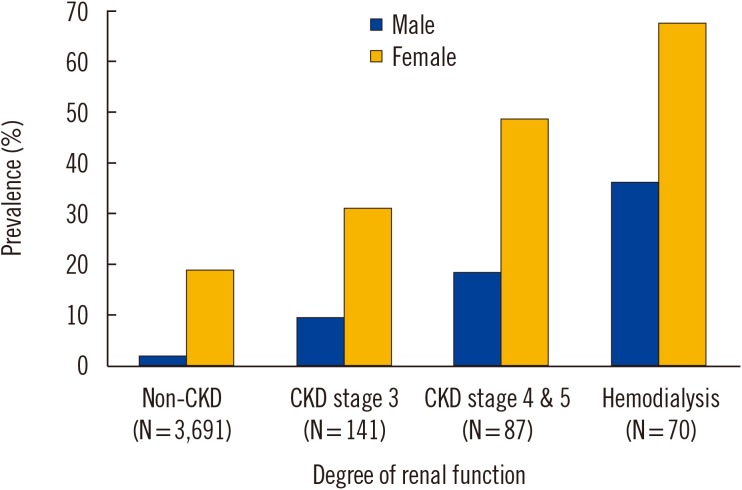Ann Lab Med.
2020 May;40(3):238-244. 10.3343/alm.2020.40.3.238.
Prevalence and Clinical Characteristics of Asymptomatic Pyuria in Chronic Kidney Disease
- Affiliations
-
- 1Department of Internal Medicine, Myongji Hospital, Hanyang University College of Medicine, Goyang, Korea. ltriver@hanmail.net
- 2Department of Laboratory Medicine, Myongji Hospital, Hanyang University College of Medicine, Goyang, Korea.
- KMID: 2466017
- DOI: http://doi.org/10.3343/alm.2020.40.3.238
Abstract
- BACKGROUND
Pyuria seems to be common in chronic kidney disease (CKD), irrespective of urinary tract infection (UTI). It has been hypothesized that sterile pyuria occurs in CKD because of chronic renal parenchymal inflammation. However, there are limited data on whether CKD increases the rate of pyuria or how pyuria in CKD should be interpreted. We investigated the prevalence and characteristics of asymptomatic pyuria (ASP) in CKD via urinary white blood cell (WBC) analysis.
METHODS
Urine examination was performed for all stable hemodialysis (HD) and non-dialysis CKD patients of the outpatient clinic (total N=298). Patients with infection symptoms or recent history of antibiotic use were excluded. Urine culture and WBC analysis were performed when urinalysis revealed pyuria.
RESULTS
The prevalence of ASP was 30.5% (24.1% in non-dialysis CKD and 51.4% in HD patients). Over 70% of the pyuria cases were sterile. The majority of urinary WBCs were neutrophils, even in sterile pyuria. However, the percentage of neutrophils was significantly lower in sterile pyuria. In multivariate logistic regression analysis, the degree of pyuria, percentage of neutrophils, and presence of urinary nitrites remained independently associated with sterile pyuria.
CONCLUSIONS
The prevalence of ASP was higher in CKD patients and increased according to CKD stage. Most ASP in CKD was sterile. Ascertaining the number and distribution of urinary WBCs may be helpful for interpreting ASP in CKD.
Keyword
MeSH Terms
Figure
Cited by 1 articles
-
Internal Quality Control Data of Urine Reagent Strip Tests and Derivation of Control Rules Based on Sigma Metrics
Haeil Park, Younsuk Ko
Ann Lab Med. 2021;41(5):447-454. doi: 10.3343/alm.2021.41.5.447.
Reference
-
1. Cabaluna CC, Gary NE, Eisinger RP. Urinalysis in patients on chronic hemodialysis. Urology. 1977; 10:103–104. PMID: 898446.2. Fasolo LR, Rocha LM, Campbell S, Peixoto AJ. Diagnostic relevance of pyuria in dialysis patients. Kidney Int. 2006; 70:2035–2038. PMID: 16883321.3. Chaudhry A, Stone WJ, Breyer JA. Occurrence of pyuria and bacteriuria in asymptomatic hemodialysis patients. Am J Kidney Dis. 1993; 21:180–183. PMID: 8430679.4. Hyodo T, Yoshida K, Sakai T, Baba S. Asymptomatic hyperleukocyturia in hemodialysis patients analyzed by the automated urinary flow cytometer. Ther Apher Dial. 2005; 9:402–406. PMID: 16202015.5. Vij R, Nataraj S, Peixoto AJ. Diagnostic utility of urinalysis in detecting urinary tract infection in hemodialysis patients. Nephron Clin Pract. 2009; 113:c281–c285. PMID: 19729962.6. Orłowska A, Majdan M, Kozioł-Montewka M, Grzebalska A, Swatowski A. Asymptomatic bacteriuria in patients on continuous ambulatory peritoneal dialysis. Ann Univ Mariae Curie Sklodowska Med. 2002; 57:285–289.7. Oikonomou KG, Alhaddad A. The diagnostic value of urinalysis in hemodialysis patients with fever, sepsis or suspected urinary tract infection. J Clin Diagn Res. 2016; 10:Oc11–Oc13.8. Davidson WJ, The S, Leigh R. Establishing a normal range for induced sputum cell counts in Western Canada. Can Respir J. 2013; 20:424–425. PMID: 24083301.9. Singh D, Edwards L, Tal-Singer R, Rennard S. Sputum neutrophils as a biomarker in COPD: findings from the ECLIPSE study. Respir Res. 2010; 11:77. PMID: 20550701.10. Levey AS, Stevens LA, Schmid CH, Zhang YL, Castro AF 3rd, Feldman HI, et al. A new equation to estimate glomerular filtration rate. Ann Intern Med. 2009; 150:604–612. PMID: 19414839.11. KDIGO. Chapter 1: Definition and classification of CKD. Kidney Int Suppl. 2013; 3:19–62.12. Kim SM, Corwin HL. Urinalysis. In : Schrier RW, editor. Diseases of the kidney. 7th ed. Philadelphia: Lippincott Williams & Wilkins;2001. p. 317–331.13. Oyaert M, Delanghe J. Progress in automated urinalysis. Ann Lab Med. 2019; 39:15–22. PMID: 30215225.14. Gilbert DN. Urinary tract infections in patients with chronic renal insufficiency. Clin J Am Soc Nephrol. 2006; 1:327–331. PMID: 17699224.15. Renko M, Tapanainen P, Tossavainen P, Pokka T, Uhari M. Meta-analysis of the significance of asymptomatic bacteriuria in diabetes. Diabetes Care. 2011; 34:230–235. PMID: 20937688.16. Eisinger RP, Asghar F, Kolasa C, Weinstein MP. Does pyuria indicate infection in asymptomatic dialysis patients? Clin Nephrol. 1997; 47:50–51. PMID: 9021242.17. Ozdem S, Bayraktar T, Oktay C, Sari R, Gültekin M. The prevalence of asymptomatic pyuria in diabetic patients: comparison of the Sysmex UF-100 automated urinalysis analyzer with Fuchs-Rosenthal hemacytometer. Clin Biochem. 2006; 39:873–878. PMID: 16919617.18. Alwall N, Lohi A. A population study on renal and urinary tract diseases. II. Urinary deposits, bacteriuria and ESR on screening and medical examination of selected cases. Acta Med Scand. 1973; 194:529–535. PMID: 4773454.19. Wise GJ, Schlegel PN. Sterile pyuria. N Engl J Med. 2015; 372:1048–1054. PMID: 25760357.20. Gupta K, Trautner B. Urinary tract infections, pyelonephritis, and prostatitis. In : Kasper D, Fauci A, editors. Harrison's principles of internal medicine. 19th ed. New York: McGraw-Hill Education;2015. p. 861–868.21. Hwang JH, Park HC, Jeong JC, Ha Baek S, Han MY, Bang K, et al. Chronic asymptomatic pyuria precedes overt urinary tract infection and deterioration of renal function in autosomal dominant polycystic kidney disease. BMC Nephrol. 2013; 14:1. PMID: 23295127.
- Full Text Links
- Actions
-
Cited
- CITED
-
- Close
- Share
- Similar articles
-
- Postoperative Microscopic Pyuria and Role of Damage-Associated Molecular Pattern: A Literature Review
- Prevalence of Pyuria and Asymptomatic Bacteriuria in High School girls in Korea
- To treat or not to treat asymptomatic hyperuricemia in chronic kidney disease
- Unusual Case of Vesicoureteral Reflux and Chronic Kidney Disease in a 10-Year-old Boy with Asymptomatic Bacteriuria
- The gut-kidney connection in advanced chronic kidney disease



